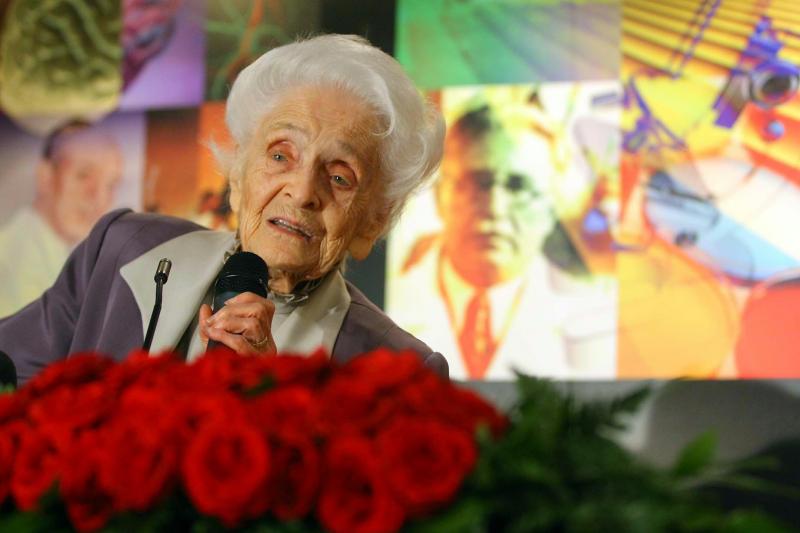This extraordinary woman carried mice in her handbag to Rio, was awarded the Nobel Prize and lived to 103!
Child of an engineer and a painter

Born on 22 April 1909 in Turin to a wealthy Italian Jewish family Rita Levi-Montalcini devoted her life to research in spite of the fact that many challenges had to be overcome for her to achieve this.
Rita referred to her family as loving and devotional and had a happy childhood. Her parents, Adamo Levi, an electrical engineer and Adele Montalcini, a painter, had four children of which Rita and her twin sister Paola were the youngest. Paola, like her mother, spent her life painting, but Rita had other ideas. Her father was not keen for her to follow a career, it was expected that the duties of a wife and mother were more important, but Montalcini was not interested in either of these roles as she felt it would distract her from her work. She attended Medical School at the University of Turin after battling for her father’s permission.
Discrimination and suppression
After qualifying in Medicine and Surgery she became an assistant to histologist Giuseppe Levi, of the same name but not related, to whom she attributes her disciplined attitude to work. However, in 1936 there were major changes when Mussolini’s fascist government passed the ‘Manifesto per la Difesa Della Razza’(Manifesto of Race) and in 1938 introduced laws which barred Jews from holding a profession or entering University .Not only did Rita have to contend with discrimination against women but also discrimination against Jews. This suppression meant that her whole family had to go into hiding .Rita Levi-Montalcini was not defeated but instead set up a Genetics laboratory in her bedroom where she continued to work on the growth of nerve fibers by studying chick embryos. The eggs apparently could still be eaten! Giuseppe Levi was also in hiding and came to work as her assistant, a reversal of roles!
In 1943 the family fled to Florence and only returned in 1945 .In Florence, in 1944, Montalcini was hired as a medical doctor and assigned to the refuge camp there.

Mice in her handbag!
Victor Hamburger was a zoologist in America whose main focus was in Experimental Embryology. In 1947 he invited Rita to Washington University in St Louis to help him in his work. This extraordinary lady traveled to Rio with a couple of live mice in her handbag! The invite was for a year or so but Rita ended up staying for 30 years! In 1947 Hamburger had found that the embryonic nervous system produces more nerve cells than needed for nerve growth of all kinds.
They worked on cancerous tissue from mice and found that when injected into chick embryos it spurred nerve growth. Biochemist Stanley Cohen joined her in Washington and was able to chemically isolate from the tumor the small secreted protein important for growth and survival of certain target neurons or nerve cells .They called it the Nerve Growth Factor or NGF.

The scientific journey
In 1956 she was made associate professor in Washington followed by full professor in1958. She set up a Research unit in Rome in 1962, which meant her time was divided between St Loius and Rome. In1961-1969 she headed the Centre of Neurobiology, also in Rome.
1969-1978 she directed the Institute of Cell Biology of the Italian National Council of Research in Rome. It was during this time that she determined the primary structure of NGF.
Although Rita retired in 1979 she continued to influence the scientific world. In 1986 she, along with her colleague Stanley Cohen, was awarded the Nobel Prize in Physiology or Medicine.
!987 saw her awarded the National Medal of Science, a prestigious American award.
Rita Levi-Montalcini was unstoppable. In 2002 she founded the European Brain Research Institute and she was given the honour by the Italian Senate to be Senator for life. In 2006, at 97 years old, she attended the opening Ceremony of the newly elected Senate.
Her 100th birthday was recognized by Rome and she attended a function held in her honour at Rome’s Town Hall .It was at this function that she expressed that her brain was sharper than when she was 20.
She died in her home in Turin on 30th December at the incredible age of 103!!
What her discovery has meant to today’s world
Montalcini set up the Levi- Montalcini foundation to grant scholarships and promote educational programmes world wide, especially for Women in Africa. It was her dream to make it possible for intelligent women to study and make a difference in their countries.
Her discoveries and work has enabled those in the field to better understand disease developmental malformations and degenerative changes such as dementia. The discovery of NGF has led to improved treatment in cancer patients. Her lifetime dedication in the field of Neurobiology has also been an inspiration and symbol of hope, showing that systematic and disciplined research can bring world changing results.
Rita Levi-Montalcini published many papers on her findings and also wrote her autobiography in 1988 ’In Praise of Imperfection, My Life and Work’ and in 1999, following a gala public celebration of her 90th birthday on April 22, she published 'Ninety Years in the Galaxy of the Mind', which described her research on the brain and discussed key research ethical issues.

Rita Levi-Montalcini was born before cars were invented yet in the modern day she even had her own Facebook page. In spite of all the challenges in her life she always worked diligently and consistently towards her vision. In her own words she said ’Above all, do not fear difficult moments.The best comes from them’.
This was a remarkable lady who has to be recognized as one of Italy’s great Treasures.
To find out more about Rita Levi Montalcini Foundation click here









